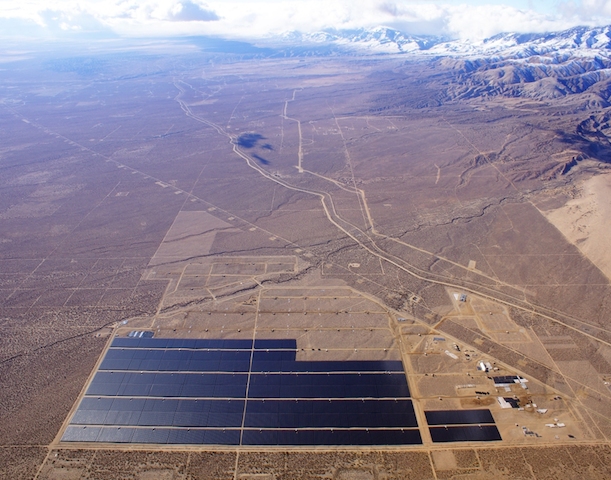Flagship Catalina Solar Project - Part of a greater hybrid renewable story
 Constructed on the floor of the driest desert in North America, the impressive 143.2 MWp Catalina Photovoltaic Solar Plant is sited outside of Rosamond, California in the Mojave Desert. Known for its extreme weather, temperature swings in the Mojave range from below 0°F (-18°C) at higher elevations to above 130°F (54°C) at its lowest elevations. The developers of Catalina executed extensive testing before selecting photovoltaic modules for the behemoth project. 82.5 MWp of Catalina are installed with CIS modules, a technology recognized for its exceptional performance in this kind of punishing environment. CIS technology is known for its low temperature coefficient; the rate of change of power output as a function of a module’s operating temperature, and that translates to higher energy output than conventional technologies in the intense Mojave heat.
Constructed on the floor of the driest desert in North America, the impressive 143.2 MWp Catalina Photovoltaic Solar Plant is sited outside of Rosamond, California in the Mojave Desert. Known for its extreme weather, temperature swings in the Mojave range from below 0°F (-18°C) at higher elevations to above 130°F (54°C) at its lowest elevations. The developers of Catalina executed extensive testing before selecting photovoltaic modules for the behemoth project. 82.5 MWp of Catalina are installed with CIS modules, a technology recognized for its exceptional performance in this kind of punishing environment. CIS technology is known for its low temperature coefficient; the rate of change of power output as a function of a module’s operating temperature, and that translates to higher energy output than conventional technologies in the intense Mojave heat.
Installed on 1,100 acres of land, Catalina was designed, constructed, and commissioned in a mechanized process. Every square foot of the Catalina project site was surveyed for the installation of high-grade, galvanized steel piles that were strategically engineered into the design to optimize the foundation to varying subsurface conditions and wind loading. The piles were placed with an advanced laser measurement system and precisely driven. Once established, multi-megawatt blocks of pre-fabricated sub-array sections were installed at the pile mounts using an all-terrain forklift. Every element of the plant was quality inspected. The streamlined construction process increased productivity by 40% over conventional panel-by-panel installation.
The Catalina project employed over 500 workers during its construction. Expected to generate 110 MWac of renewable electric power, the project offsets 74,000 metric tons of greenhouse gas emissions annually. The clean energy is provided to San Diego Gas & Electric Company (SDG&E) under a 25-year Power Purchase Agreement.
What makes Catalina even more noteworthy is that it’s part of an even greater success story; a hybrid, renewable energy project. Extreme temperature changes in the Mojave Desert generate another weather phenomenon, wind. Adjacent to Catalina is the 140 MW Pacific Wind project. The proximity of these two renewable energy projects enabled them to share specific infrastructure elements, optimizing installation activities and reducing construction costs. Although contracted and developed independently, the tandem development promoted shared resources for mitigation land and certain infrastructure facilities. For both projects, developing and permitting consumed a great deal of time in due diligence. California has a large number of endangered species. There are various animals, birds, and plants with special status that need to be taken into consideration. The projects navigated complex regulations and environmental laws requiring strict documentation. Costs were shaved by reducing some duplicate work and processing. These projects began separately with different interconnect agreements and power purchase agreements, but it became apparent if projects in the future began the planning process as hybrids, they could capture more efficiencies in terms of siting, permitting, and various types of infrastructure.
A crucial piece of this success story was the addition of a 7.2-mile (11.6-kilometer), 230-kV transmission line engineered and constructed in the short turnaround time of 9 months. In the Antelope Valley area, where the renewable energy projects were developed, the sun shines during the day and the wind often blows in the evening. The wind is usually less strong during hot summer days when solar is at its peak. While the projects are two intermittent energy generators, the two technologies complement each other in terms of production and hours of production. Each renewable resource is generating name-plate power during different periods. The transmission line connects to the ambitious Tehachapi Renewable Transmission Project, the interconnect to Southern California Edison and was built for the renewable energy corridor. The power line does double duty, maximizing usage and benefitting both rate-payers and grid operators. Together, the projects will generate enough green electricity to power 91,000 households.
The reality, in the race to move this country to a sustainable energy generation structure, is that many viable options are needed. The magnitude of this hybrid project is a milestone accomplishment, exemplifying how invaluable experienced, renewable energy teams are. Catalina’s energy production in the months following construction met and exceeded modeling. It is a leading-edge guide of how skilled development and construction teams can leverage the characteristics of a geography, and their technical knowledge to advantageously match renewable energy generation technologies and launch a new hybrid project standard.
Cary Vandenburg is the vice president of business development and managing director of development at Solar Frontier Americas.
Solar Frontier | www.solar-frontier.com
Volume: July/August 2015









.jpg?r=6049)
.gif?r=6684)

.jpg?r=5306)